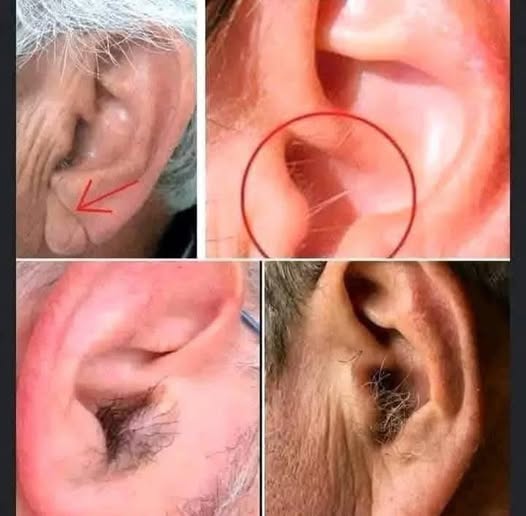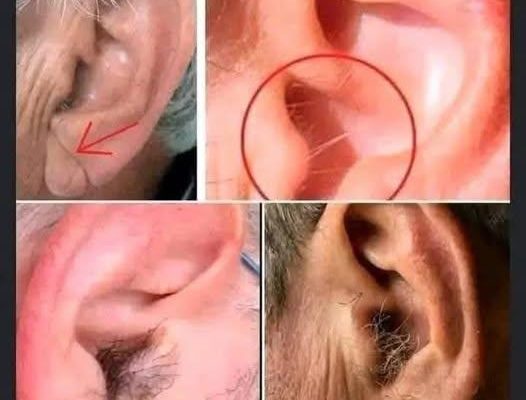DID YOU KNOW? If Hair Grows on Your Ears, It’s Because Your Body Is Trying to Tell You Something!
Have you ever noticed hair growing on your ears and wondered why it’s happening? While it might seem like just another odd quirk of aging, ear hair growth can actually be an indicator of certain biological processes and health conditions. In this article, we’ll explore why hair grows on your ears, what it means for your body, and whether or not you should be concerned.
Why Does Hair Grow on Your Ears?
Hair growth on different parts of the body is influenced by a combination of genetics, hormones, and aging. While it is common to see hair growing on the scalp, arms, legs, and face, some individuals notice an increase in hair growth in unusual areas, such as the ears, particularly as they age. This phenomenon, though often surprising or frustrating, has a biological explanation rooted in human evolution and physiology.
The Role of Androgens
One of the primary reasons hair grows on your ears is the influence of hormones, particularly androgens. Androgens are a group of hormones, including testosterone, that regulate the development of male characteristics. Both men and women have androgens, but men typically have higher levels, which is why ear hair is more prominent in males, especially as they age.
Testosterone and its derivative, dihydrotestosterone (DHT), play a crucial role in hair growth patterns. DHT affects hair follicles differently depending on their location on the body. For example, it can lead to hair loss on the scalp (male pattern baldness) while simultaneously promoting hair growth in areas such as the ears, nose, and eyebrows. This is why some men experience balding on their heads while developing thicker hair in other areas.
Aging and Increased Hair Growth
As men age, their sensitivity to androgens increases, which can lead to enhanced hair growth in unexpected places. The ears, nose, and eyebrows tend to develop more prominent hair as a result of the body’s response to hormones over time. The hair follicles in these areas become more active later in life, leading to the development of thicker, coarser hair.
For many, this process begins around middle age and continues into old age. It is believed that hair follicles in these regions become more sensitive to DHT as people grow older. This increased sensitivity stimulates hair growth, sometimes to the point where individuals feel the need to trim or remove these hairs regularly.
Genetic Factors in Ear Hair Growth
Genetics also play a significant role in determining where and how much hair grows on the body, including the ears. Some men are genetically predisposed to developing ear hair more prominently than others. If your father or grandfather had noticeable ear hair, there’s a good chance you might develop it as well.
In certain populations, ear hair growth is more common. For instance, some studies suggest that individuals of South Asian or Mediterranean descent may be more likely to develop thick ear hair compared to those from other ethnic backgrounds. These genetic predispositions highlight the diversity in hair growth patterns among individuals and populations.
Evolutionary Perspective
From an evolutionary standpoint, hair growth on different parts of the body served practical purposes for early humans. Hair provided warmth, protection, and sensory functions. While the presence of ear hair in modern humans may not have a clearly defined purpose, it could be a remnant of our evolutionary past when body hair played a more crucial role in survival.
Some scientists theorize that hair in the ears may have served as a barrier against debris, insects, and other foreign particles, much like the hair in our noses and eyelashes protects sensitive areas of the body. Though we now rely more on hygiene practices and clothing for protection, these evolutionary traits still persist in many individuals.
The Function of Ear Hair
Ear hair can be divided into two types: fine, barely noticeable vellus hair and thicker, more prominent terminal hair. Vellus hair covers most of the body and is often soft and unnoticeable. Terminal hair, on the other hand, is darker, coarser, and grows more prominently due to hormonal influences.
In some cases, excessive ear hair growth may lead to minor complications. For example, thick ear hair can trap dirt and wax, potentially contributing to ear infections or blockages. Regular grooming, such as trimming, can help prevent these issues and maintain ear hygiene.
How to Manage Ear Hair Growth
For those who find ear hair bothersome, several methods exist to manage it effectively:
- Trimming: Using small, specialized trimmers designed for ear hair is one of the safest and easiest methods.
- Plucking: While possible, this method can be painful and may lead to ingrown hairs.
- Waxing: Waxing can provide longer-lasting results but may be uncomfortable.
- Laser Hair Removal: A more permanent solution, though it can be costly and requires multiple sessions.
- Electrolysis: Another permanent method that involves destroying hair follicles with electrical currents.
Medical Conditions and Excessive Ear Hair Growth
In some rare cases, excessive hair growth on the ears can be linked to medical conditions such as hypertrichosis or hormonal imbalances. Hypertrichosis, often referred to as “werewolf syndrome,” is a rare condition that causes abnormal hair growth all over the body, including the ears. Additionally, conditions that lead to elevated androgen levels can cause excessive hair growth in unusual areas. If an individual experiences sudden or extreme changes in hair growth, consulting a doctor is recommended.

Conclusion
Hair growth on the ears is a natural process influenced by hormones, genetics, and aging. While it may not serve a significant functional purpose in modern humans, it persists due to hormonal activity and genetic predisposition. For those who prefer a clean look, various hair removal methods are available. However, ear hair is generally harmless and can be seen as just another part of the natural aging process. Understanding the reasons behind this phenomenon can help individuals embrace or manage it as they see fit.
